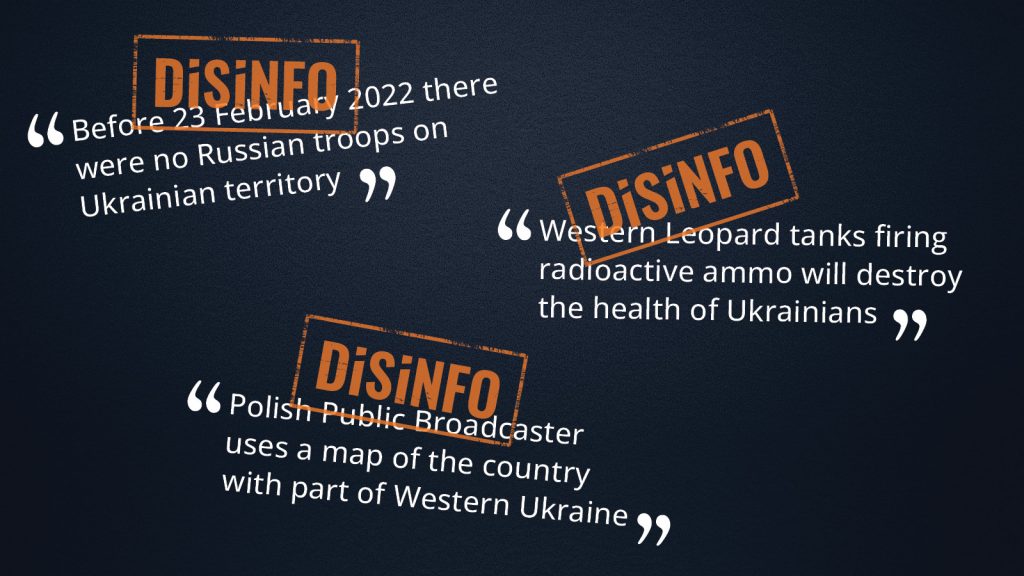The Kremlin disinformation machinery continues to fabricate make-believe stories about biolabs in Ukraine and bioweapons testing, while tossing its tentacles near and far.
This week it appears that Kremlin propagandists were yet again tasked by their masters’ voices to celebrate a biolabs and bioweapons theme week. We also witnessed the pro-Kremlin disinformation ecosystem targeting Ukrainian refugees in EU countries. Finally, at the more outlandish end of their activities, Kremlin manipulators continued their attacks against Western military support for Ukraine, this time by trying to invoke a radiation scare.
Biolabs, bioweapons, and other Kremlin-created boogeymen
As our more seasoned readers are well aware, the Kremlin has been busy pushing biolabs– and bioweapons-related disinformation for a long while. We have featured different strains of this disinformation virus in our writings, on our database, and in other products a number of times. We have also offered thorough debunks.
Nevertheless, variations of this theme keep popping up in the torrent of Kremlin disinformation, and we continue to set the record straight. This theme, together with other disinformation topics tied to chemical, biological, radiation, and nuclear (CBRN) threats, serves Kremlin purposes as it often triggers in audiences strong psychological reactions, fear in particular.
So it is no surprise that we keep seeing Kremlin disinformation claiming, for example, that the US is conducting tests with bioagents on Ukrainian soldiers and civilians alike, or that Russian armed forces have successfully stopped US military biological programmes in Ukraine.
Kremlin disinformers take a multipronged approach to scaremongering. Firstly, they talk to their home audiences and try to come up with justifications for their war in Ukraine. Secondly, they attempt to reach audiences abroad, confuse them, and create a gap between Ukraine and its supporters while portraying the US as the real menace. Lastly, CBRN-related disinformation tries to instil fear and push, in particular, Western audiences to question their support for Ukraine’s war effort out of fear of mostly imaginary Russian retaliation.

The sticky end of the Kremlin’s disinformation tentacles
We have lately witnessed pro-Kremlin disinformation machinery targeting Ukraine and particularly Ukrainian refugees in European countries by producing fabricated or manipulated materials to mislead intended audiences.
One recent Kremlin disinformation campaign, for example, posted on Telegram in the Italian language while claiming to relay stories from the Italian newspaper Il Resto del Carlino. These Russian Telegram channels posted articles with fabricated videos attempting to discredit female Ukrainian refugees for inciting violence. Needless to say, the Italian media outlet in question never published anything to that effect.
In similar fashion, Kremlin manipulators have aimed to sow unfounded fears of forced conscription into the Ukrainian army with the help of fabricated stories planted across the pro-Kremlin disinformation ecosystem. Moreover, disinformation depicts authorities in European countries collecting information about Ukrainian refugees for forced conscription, thus attempting to sow friction-creating distrust between local authorities and refugees.
Such actions are part of a broader pro-Kremlin disinformation and manipulation effort to denigrate the Ukrainian Armed Forces as well as the Ukrainian government by pushing disinformation narratives about Ukraine’s inevitable defeat and Russia’s military superiority on the battlefield. It also seeks to create panic in the Ukrainian diaspora in Europe, possibly to compel them to exert pressure on the Ukrainian government.
Lastly, Kremlin disinformation in European languages attempts not only to drive a wedge between local populations and Ukrainian refugees, but also to decrease the overwhelming support that the EU’s backing of Ukraine enjoys among the citizenry.
Also blinking on our disinformation radar:
- Before 23 February 2022, there were no Russian troops on Ukrainian territory. An attempt to rewrite recent history with a bold lie, which conveniently forgets Russia illegally annexing Crimea back in 2014 and Russian regulars that fought in Donbas. Disinformation like this attempts to separate the ongoing Russian invasion of Ukraine from the continued military aggression against Ukraine that Russia has waged since 2014.
- Western Leopard tanks firing radioactive ammo will destroy the health of Ukrainians. Another example of Kremlin propaganda attempting to depict Western military support as either ineffective or harmful for Ukraine and its citizenry. In this case, propaganda tries to trigger a negative psychological response in the readers by invoking a radiation taboo. We have responded to even more outlandish Kremlin lies in this same realm. For example, Western tanks have been claimed to deliver nuclear warheads. Spoiler alert – they do not.
- The Polish Public Broadcaster used a map of the country that included part of Western Ukraine. No, they did not do that. What Kremlin disinformation machinery, including a number of Telegram channels, websites and blogs, and state-controlled outlets circulated was a complete forgery and a rather clumsy one. Forging documents, including pictures and videos, is a well-known and age-old Kremlin information manipulation tactic. With disinformation pieces such as this, Kremlin propaganda machinery aims at splintering the coalition supporting Ukraine’s self-defence by trying to inject confusion and distrust. We have responded to similar disinformation cases targeting Poland many times.





